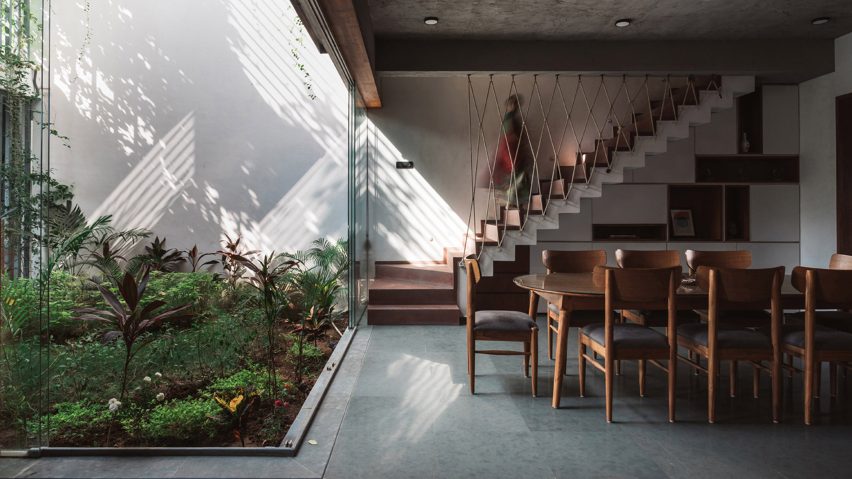Living spaces at this house in the Indian city of Surat are arranged around a verdant courtyard lined with glass walls that can be retracted to open the interior up to the outdoors.
Local architecture office Neogenesis+Studi0261 designed the house for an agriculturalist and his family, who wanted be able to look out at lots of greenery despite their home's urban setting.
The property is located in the city on the coast of the Indian state of Gujarat, where the climate is typically dry throughout the year until the monsoon rains arrive around mid June.
The house is flanked on either side by existing homes with a suburban character and is designed to make the most of the available natural light.
The architects gave the project the title Jungalow because of the copious amount of planting incorporated throughout the building, which lends it a verdant feel despite the lack of a proper garden.
"Abstraction of urban farming can be seen in both exterior and interior spaces," said the studio.
"The basic building materials are kept to their natural form and texture to comprehend the naturality of flora."
The facade incorporating the main entrance faces onto a laneway that provides access to a garage, above which are a series of stepped terraces and balconies.
A set of steps leads to a foyer lined with a trellis that opens into an open-plan living space occupying most of the ground floor.
The lounge and dining space are arranged around the double-height courtyard, which is flanked on one side by the trellis.
Creepers and climbing plants help to shade the interior from direct sunlight, while the full-height retractable glazing ensures an uninterrupted connection with the outdoor space.
The courtyard is topped with a circular opening that allows natural light to filter down. A matching circular window overlooks the garden from the master bedroom above.
The main lounge space on the ground floor is connected by a set of louvred wooden doors to a large enclosed terrace with built-in concrete planters.
Also on this level is a shrine based on the Shikhara – a pyramid-like structure found in some Hindu temples. The shrine is positioned at the base of a triple-height void that allows daylight to flood into the heart of the building.
Stairs ascend from the dining area to a family room occupying the first-floor landing, which is surrounded by three en-suite bedrooms.
The master bedroom features sliding glass doors that open onto a private balcony sheltered beneath a cantilevered roof. Plants spill over from the edge of the balcony to overhang the terrace below.
The stairs continue from the family area to a second floor accommodating a further two bedrooms. Fitted timber joinery throughout the rooms offers a warm contrast to the stone flooring and rough, plastered walls.

